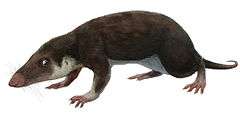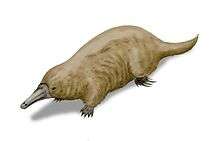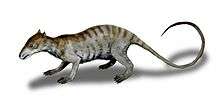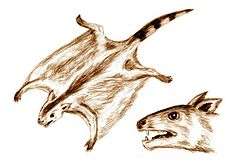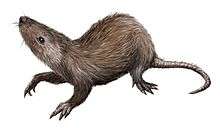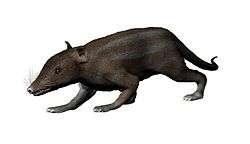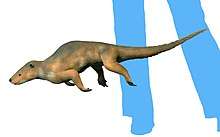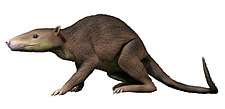Sinoconodon
Sinoconodon rigneyi[1] is an ancient mammaliamorph or early mammal (depending on systematic approach) that appears in the fossil record of the Lufeng Formation of China in the Sinemurian stage of the Early Jurassic period, about 193 million years ago.[2] While in many traits very similar to non-mammalian synapsids, it possessed a special, secondarily evolved jaw joint between the dentary and the squamosal bones, which had replaced the primitive tetrapod one between the articular and quadrate bones, a trait commonly used to define mammals.[3][4]
| Sinoconodon | |
|---|---|
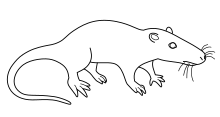 | |
| Restoration of S. rigneyi | |
| Scientific classification | |
| Kingdom: | Animalia |
| Phylum: | Chordata |
| Clade: | Therapsida |
| Clade: | Cynodontia |
| Genus: | †Sinoconodon Patterson & Olson, 1961 |
| Species: | †S. rigneyi |
| Binomial name | |
| †Sinoconodon rigneyi | |
| Synonyms | |
|
List
| |
Although the animal is closely related to Morganucodon, it is regarded as the most basal of the mammaliaforms.[5] It differed substantially from the more mammalian Morganucodon in its dental and growth habits. Like other non-mammalian tetrapods, such as reptiles and amphibians, it was polyphyodont, replacing many of its teeth throughout its lifetime, and it seems to have grown slowly but continuously until its death. Sinoconodon is thus less mammalian than early mammaliaforms like docodonts and morganucodonts.[3][6] The dentition of Sinoconodons can be arranged in a series of increasing lengths[7] The combination of basal tetrapod and mammalian features makes it a unique transitional species. There are simply no animals like it alive today.[8]
Taxonomy
Sinoconodon was named by Patterson and Olson in 1961. Its type is Sinoconodon rigneyi. It was assigned to Triconodontidae by Patterson and Olson in 1961; to Triconodonta by Jenkins and Crompton in 1979; to Sinoconodontidae by Carroll in 1988; to Mammaliamorpha by Wible in 1991; to Mammalia by Luo and Wu in 1994; to Mammalia by Kielan-Jaworowska et al. in 2004; and to Mammaliaformes by Luo et al. in 2001 and Bi et al. in 2014.[9]
Phylogeny
| Mammaliaformes |
| ||||||||||||||||||||||||||||||||||||||||||||||||
Sinoconodon[10][11] differs from all nonmammalian cynodonts in the presence of a promontorium, an enlarged anterior lamina, and the floor of the trigeminal ganglion. Sinoconodon shares several derived characters with other mammals. The most distinguished are the expansion of the brain vault in the parietal region, complete ossification of the medial wall of the orbit, a large dentary condyle, and a concave glenoid fossa in the squamosal. These characters suggest that Sinoconodon and other mammals form a monophyletic group. In addition, Sinoconodon developed some autapomorphic characters: a large occipital condyle; and, relative to skull length, postdentary bones more reduced in size than in the other known Liassic mammals. These characters suggest that Sinoconodon is the sistergroup to a taxon that includes all other mammals because Sinoconodon lacks a number of diagnostic apomorphies shared by Morganucodon, Dinnetherium, and other mammals.[10][12]
Relationships
The evolutionary transition to the mammalian type of jaw joint was associated with changes in body size, structure of the ear, structure of the skull, structure of the teeth, and, consequently, the type of diet that distinguishes mammals from other vertebrates. Morganucodon can still be regarded as the best known of the earliest mammals. The skull, lower jaw, and postcrania of this small mouse-sized mammal are well preserved and have provided the basis for many ideas of mammal origins.
Sinoconodon presents morphological data that forces a modification of ideas of mammal origins based primarily on Morganucodon. Sinoconodon is known only from the skull and lower jaws. It is younger geologically than some Morganucodon, but Sinoconodon has many features which are more primitive than Morganucodon. Particularly significant is the dentition of Sinoconodon, in which the postcanine tooth row consists of five multicuspid trenchant teeth with only the vestiges of cingula. These teeth do not precisely occlude with one another. They do not look like typical mammalian teeth, which do occlude precisely and have distinct cingula and cusps offset from a single longitudinal row. Indeed, precise occlusion is thought to have evolved very early in the evolution of mammals, in Morganucodon itself.[13]
Description
Jaw and Skull
A lack of morphological information makes it difficult to interpret the relationships of advanced cynodonts and early mammals. To address this problem, skulls and dentition of Sinoconodon and Morganucodon were studied.[7] Among all known skull specimens of Sinoconodon, the smallest is a length of 14mm from the rostrum to the posterior end of the tooth row (skull length estimated between 20 and 22mm). Dental replacement in Sinoconodon is characterized by more than three replacements of the incisors, at least five replacements of the canines, and one replacement of the premolars and the posterior molars, as seen in many non-mammalian cynodonts. The replacing the premolars and the anterior molars are permanently lost, enlarging the post canine diastema in the older specimens. The single replacement of at least some posterior molars and the differentiation of premolars from molars may be a general condition in the stem group of mammals.[14]
The skull experienced indeterminate growth while the teeth were being replaced in adult specimens. The dental replacement of Sinoconodon could be interpreted as an intermediate stage in the character evolution from the primitive pattern of polyphyodont replacement seen in most cynodonts to the derived diphyodont replacement of mammals. From the polypyodont replacement and the substantial growth of the adult skulls of Sinoconodon, it is inferred that this taxon lacked the lactation and determinate growth of living mammals.[14]
In other aspects Sinoconodon is more primitive; precise post-canine occlusion is lacking, the mandibular symphysis is deep, the jaw articulation lies below a line projected through the apices of the teeth, the pterygoparoccipital foramen is large and the post-canine teeth cannot be divided into molars and premolars. The jaw articulation and braincase of Sinoconodon are compared with those of the two cynodont therapsids Probainognathus and Thrinaxodon. It is concluded that in the transition from therapsid to mammal the medial surface of the groove in the squamosal housing the quadrate was lost and, as a result, in Sinoconodon, Morganucodon and Dinnetherium the hollow medial surface of the quadrate abutted directly against the paroccipital process.[7][15] Morganucodon are more closely related to the crown group than is Sinoconodon due to the upper and lower molars have one-to-one occlusal relationship and the opposing molars develop wear facets from this precise deal occlusion. Morganucodon are also more similar to the crown mammalian group than Sinoconodon in a number of features of the cranio-mandibular joint, a longer cochlear canal, and a slightly larger cranial capacity.[13]
References
- Paleofile.com (net, info) . "Taxonomic lists- Mammals". Retrieved 30 December 2015.
- Lucas, Spencer (2001). Chinese Fossil Vertebrates. New York: Columbia University Press. pp. 130–150. ISBN 978-0231084833.
- Kielan-Jaworowska, Z; Luo, ZX; Cifelli, RL (2004). Mammals from the Age of Dinosaurs. Columbia University Press. Chapter 4. ISBN 9780231119184.
- Luo, Z.-X. (2005). "FOSSIL VERTEBRATES | Mesozoic Mammals". Encyclopedia of Geology. Elsevier. pp. 527–534. doi:10.1016/b0-12-369396-9/00008-3. ISBN 9780123693969.
- Luo, ZX; Kielan-Jaworowska, Z; Cifelli, RL (2002). "In quest for a phylogeny of Mesozoic mammals". Acta Palaeontologica Polonica. 47 (1): 1–78.
- Close, Roger A.; Friedman, Matt; Lloyd, Graeme T.; Benson, Roger B.J. (August 2015). "Evidence for a Mid-Jurassic Adaptive Radiation in Mammals". Current Biology. 25 (16): 2137–2142. doi:10.1016/j.cub.2015.06.047. ISSN 0960-9822. PMID 26190074.
- CROMPTON, A. W.; SUN, AI-LIN (October 1985). "Cranial structure and relationships of the Liassic mammal Sinoconodon*". Zoological Journal of the Linnean Society. 85 (2): 99–119. doi:10.1111/j.1096-3642.1985.tb01500.x. ISSN 0024-4082.
- Mammals of the Mesozoic: The least mammal-like mammals
- "PBDB". paleobiodb.org. Retrieved 2018-05-21.
- Close, Roger A.; Friedman, Matt; Lloyd, Graeme T.; Benson, Roger BJ (2015). "Evidence for a mid-Jurassic adaptive radiation in mammals". Current Biology. 25 (16): 2137–2142. doi:10.1016/j.cub.2015.06.047. PMID 26190074.
- Cifelli, Richard; Hurum, Jørn Harald; Borsuk-Białynicka, Magdalena; Luo, Zhexi; Kaim, Andrzej (2015). "Zofia Kielan-Jaworowska (1925–2015)". Acta Palaeontologica Polonica. 60. doi:10.4202/app.00183.2015. ISSN 0567-7920.
- Jenkins, Ian (July 1996). "N. C. Fraser & H. D. Sues (eds) 1995. In the Shadow of the Dinosaurs. Early Mesozoic Tetrapods. x + 435 pp. Cambridge, New York, Port Chester, Melbourne, Sydney: Cambridge University Press. Price £50.00, US $89.95 (hard covers). ISBN 0 521 45242 2". Geological Magazine. 133 (4): 502. doi:10.1017/s0016756800007706. ISSN 0016-7568.
- Zofia., Kielan-Jaworowska (2004). Mammals from the age of dinosaurs : origins, evolution, and structure. Cifelli, Richard., Luo, Zhe-Xi. New York: Columbia University Press. ISBN 978-0231119184. OCLC 55535025.
- Crompton, Alfred W.; Luo, Zhexi (1993). Mammal Phylogeny. New York, NY: Springer New York. pp. 30–44. doi:10.1007/978-1-4615-7381-4_4. ISBN 9781461573838.
- Luo, Zhexi; Crompton, Alfred W. (1994-09-07). "Transformation of the quadrate (incus) through the transition from non-mammalian cynodonts to mammals". Journal of Vertebrate Paleontology. 14 (3): 341–374. doi:10.1080/02724634.1994.10011564. ISSN 0272-4634.
